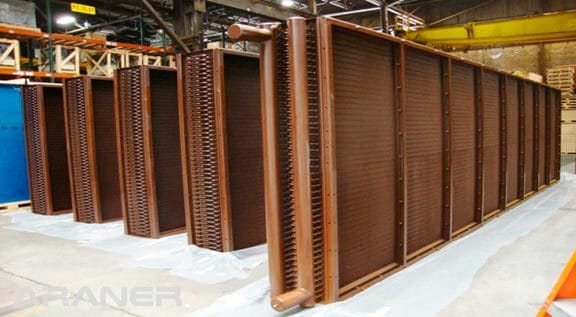Industrial process chilling systems come with four main components: evaporator, throttle valve/ expansion valve, compressor and condenser. All these components demand a lot in terms of initial investment and the subsequent operating costs. In many industries, chillers are the single most energy consumers, so a comprehensive maintenance program is necessary. Predictive maintenance is common, but preventive maintenance is still the best way to ensure sustenance of chiller efficiency. Notably, chiller efficiency has increased steadily in recent decades because of advanced design of refrigerants, equipment and controls. This has only served to make regular service a crucial part of the preventive maintenance process. As an engineering or maintenance manager, you cannot afford to overlook condenser cleaning for air-cooled systems.
] 
Fig 1: Condenser Heat Exchanger
As most maintenance engineers will tell you, most condensing units and chillers are placed in non-easy access areas, like rooftops. Combine this with the fact that cleaning such components is not a pleasant job for most people. In cases where the maintenance team is overstretched, instances of condenser coil cleaning being deferred are common.
Is condenser cleaning that important?
The simple answer is YES. We will see why. Whether you are talking about annual health checkups or the routine check of your car engine oil, prevention of major problems is done through proactive care. The unfortunate thing is that we tend to forget these important things quite often. The condition of the condenser coils can have an effect on the overall system efficiency. The gist of the matter is that every year, the chiller system draws a substantial amount of air over the coils. Some of the contents of outside air include:
- Vegetation clippings
- Dust
- Dirt
- Debris
- Pollen
Because there is no guarantee that the air filter will be excellent throughout the year, some of this outside matter will eventually cover the condenser coils. What happens when these components remain on the condenser coils unattended? The system must now work harder to pull the same amount of air. Moreover, the settling of these components creates the perfect breeding ground for bacteria. As the bio-contaminants cover the coils, what follows is the infestation of the air with mold and bacteria, which could affect the health of facility workers.
Two Levels of Chiller Failure
The HVAC industry has two levels of chiller failure. The slightest fouling of the condenser coils that you can imagine can cause this. The characteristics of the first level of failure include:
- Compressor cycling on and off frequently
- Reduced cooling tonnage capacity
- Increased compressor head pressure and electrical consumption
- Unit has to work harder and run longer for same temperature points
You will know that the chiller has high-head pressure problems through increased energy costs, low employee productivity and general discomfort of occupants. Having an energy management system can help you detect the energy penalty; otherwise, you may only come to learn about the issue when the compressor finally fails. Chillers used for process cooling can overheat and affect the quality of products. If the fouling problem is not detected and remedied, the equipment may fail. We are talking about press equipment, process control equipment and the likes. The second level of failure is essentially when the compressor can no longer function normally. In most cases, the equipment fails, meaning that management has to organize for a replacement. During the procurement of the compressor and in the absence of a backup unit, the loss due to downtime can be enormous. Daily loss for some computer-controlled production lines can be as much as $200,000. Now, consider these other cost implications:
- Coil cleaning cost
- Startup cost of production equipment
- Compressor replacement cost
- Some workers sent home until equipment is back
Reasons for Deferment
From our interactions with maintenance and facility directors, budgetary constraints are sometimes too much. Some companies have also postponed or even ignored the dirt on their condenser coils because of resource constraints and knowledge inadequacy. The unfriendliness of this maintenance process is also a common reason for this disregard. The list can be endless, but one fact remains- postponing or ignoring maintenance of condenser coils in air cooled systems is a risky affair that not only increases the odds of equipment failure, but also puts a dent in the company’s revenues.
The Bottom Line
Cleaning condenser coils in air-cooled systems offers many economic, safety and health benefits. It will also save you money and keep the chiller running for longer. We recommend that you clean the coils at least annually, but you could do it more frequently depending on conditions in your area. If you have any questions about this important maintenance procedure, contact our specialists. If you enjoyed this post, you may be want to read TIAC as an environmental energy solution.









